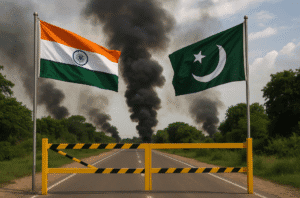India-Pakistan Trade Surge: 127% Growth Amid Deadly Tensions – How Economics Defy Diplomacy!
Despite escalating tensions following the 2025 Pahalgam terror attack, India-Pakistan trade hit a five-year high in 2024, with bilateral commerce surging 127% to $1.21 billion. India’s exports—led by pharmaceuticals, chemicals, and sugar—reached $1.21 billion, buoyed by Pakistan’s economic instability and reliance on affordable Indian goods. However, Pakistan’s exports to India collapsed to $480,000 due to India’s 200% tariffs post-2019 Pulwama attack.
While political hostilities persist, necessity drives limited trade through informal channels (e.g., UAE intermediaries) and partial exemptions for critical items. The asymmetry underscores India’s dominance, with Islamabad struggling to replace cost-effective imports amid soaring inflation. Though the Pahalgam attack renews calls for stricter sanctions, existing measures have already minimized formal trade, leaving informal exchanges vulnerable to geopolitical shocks.
This paradox reveals how grassroots economic needs persist beneath diplomatic frost, yet the relationship remains fragile, tethered to cycles of violence and pragmatism.

India-Pakistan Trade Surge: 127% Growth Amid Deadly Tensions – How Economics Defy Diplomacy!
Despite a deadly terror attack in Jammu and Kashmir’s Pahalgam on April 22, 2025—claimed by a Pakistan-linked militant group—bilateral trade between India and Pakistan surged unexpectedly in 2024, underscoring a complex interplay of economic pragmatism and geopolitical strife.
The Trade Surge Defying Diplomatic Frost
India’s merchandise exports to Pakistan reached $1.21 billion in 2024, the highest since 2018, while total bilateral trade skyrocketed 127% year-on-year to $1.21 billion. This growth is striking given the near-collapse of diplomatic relations following India’s revocation of Jammu and Kashmir’s special status in 2019 and Pakistan’s retaliatory suspension of trade. However, Islamabad’s partial reversal of this ban—citing inflationary pressures—allowed limited trade to resume, fueling India’s exports of pharmaceuticals, organic chemicals, and sugar.
Pakistan’s exports to India, meanwhile, collapsed to a mere $480,000 in 2024 (down from $547 million in 2019), reflecting the impact of India’s 200% customs duty hike on Pakistani goods post-2019 Pulwama attack. New Delhi’s massive trade surplus with Islamabad highlights an asymmetrical reliance, with Pakistan struggling to replace Indian products amid economic instability.
Historical Context: From Pulwama to Article 370
The 2019 Pulwama attack marked a turning point. India’s withdrawal of Pakistan’s Most Favored Nation (MFN) status and punitive tariffs crippled Islamabad’s exports, which previously included textiles, minerals, and cement. Pakistan’s subsequent suspension of bilateral trade—partially walked back due to domestic inflation—failed to curb India’s export dominance.
Despite these measures, informal channels and third-country intermediaries (e.g., UAE and Singapore) have kept trade alive. Indian pharmaceuticals, for instance, often reach Pakistan via Dubai, circumventing political barriers. Similarly, Pakistani textiles enter Indian markets through indirect routes.
Key Commodities: What’s Traded and Why
- India’s Exports: Critical goods like life-saving drugs, vaccines, and industrial chemicals dominate, sectors where Pakistan lacks self-sufficiency.
- Pakistan’s Exports: Reduced to minimal quantities of apparel and construction materials, reflecting India’s strategic tariffs.
Experts suggest Pakistan’s economic crisis—including a 40% inflation rate in 2023—compelled it to prioritize cost-effective Indian imports over political posturing. “Necessity overrides diplomacy,” notes a South Asia trade analyst. “Indian generics are 30–50% cheaper than alternatives, making them irreplaceable for Pakistan’s healthcare sector.”
The Pahalgam Attack: Will Trade Survive?
The 2025 Pahalgam attack, one of the deadliest in decades, has reignited calls for stricter trade sanctions. However, analysts argue that existing measures have already minimized formal trade, leaving little room for escalation. “India’s exports to Pakistan remain a fraction of their $2.35 billion peak in 2018. Further restrictions would hurt Pakistani citizens more than its government,” explains a geopolitical strategist.
Yet, symbolic responses are likely. India may expand its “terror financing” watchlist to Pakistani trade entities or tighten scrutiny on third-country rerouting. Conversely, Pakistan’s reliance on Indian agricultural products (e.g., sugar) could force quiet negotiations to sustain limited exchanges.
Conclusion: A Relationship of Contradictions
The India-Pakistan trade paradox reveals a harsh reality: economic needs often persist beneath political hostilities. While security concerns dominate headlines, grassroots demand for affordable goods sustains fragile commercial links. However, with trust at an all-time low and violence escalating, even these tenuous ties remain vulnerable to sudden collapse.
As both nations brace for diplomatic fallout from Pahalgam, the resilience—or fragility—of their trade relationship will serve as a barometer for the broader geopolitical climate in South Asia.
Why This Matters
- Economic Interdependence: Highlights how targeted trade policies impact civilian populations.
- Security vs. Trade: Examines whether commerce can coexist with cross-border terrorism.
- Regional Stability: Underscores the role of third countries in mediating indirect trade.
You must be logged in to post a comment.